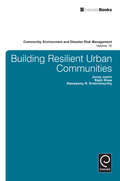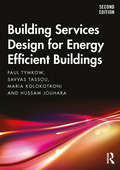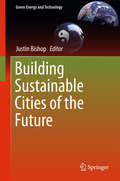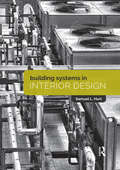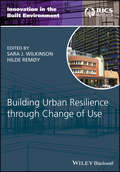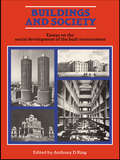- Table View
- List View
Building Resilient Neighbourhoods in Singapore: The Convergence of Policies, Research and Practice (Advances in 21st Century Human Settlements)
by Chan-Hoong Leong Lai-Choo Malone-LeeThis book examines how institutional and environmental features in neighbourhoods can contribute to social resilience, highlighting the related socio-demographic issues, as well as the infrastructure, planning, design and policies issues. It is divided into three themes – infrastructure, planning, and community. Infrastructure examines how physical features such as parks and street patterns influence neighborliness and resilience, while planning studies how urban design enhances social interactions. Lastly, community discusses policies that can forge social bonds, either through racial integration, grassroots activities, or social service. Overall, the book combines research and empirical work with scholarly models of resilience and governance philosophy, focusing on Singapore’s urban planning and social policies.
Building Resilient Organizations: Proceedings of the 4th International Conference on “Impact of Current Events on the Future of Business” (4th ICEFB, 2022), Hyderabad, Telangana, India on 7-9 April, 2022
by Falguni H Pandya Sheelam Jain Niharika AtchyutuniThis book is aimed at contemplating and reflecting on future course of action for businesses in order to become more resilient. It discusses various predicaments and prospects around building enduring organizations. By demonstrating how to build strong and resilient systems that can survive catastrophes witnessed in the past few years, it offers practical solutions by discussing the current researches, the-oretical insights, experiences and lessons which can inspire and empower business leaders, academics, students, policy makers and other stakeholders in economics.
Building Resilient Organizations: Proceedings of the 4th International Conference on “Impact of Current Events on the Future of Business” (4th ICEFB, 2022), Hyderabad, Telangana, India on 7-9 April, 2022
by Falguni H. Pandya Sheelam Jain Niharika AtchyutuniThis book is aimed at contemplating and reflecting on future course of action for businesses in order to become more resilient. It discusses various predicaments and prospects around building enduring organizations. By demonstrating how to build strong and resilient systems that can survive catastrophes witnessed in the past few years, it offers practical solutions by discussing the current researches, the-oretical insights, experiences and lessons which can inspire and empower business leaders, academics, students, policy makers and other stakeholders in economics.
Building Resilient Urban Communities (Community, Environment and Disaster Risk Management #15)
by Jonas Joerin Rajib Shaw R. R. Krishnamurthy"How do urban communities in Asian cities experience the impacts of urbanisation and climate change? This book throws light on the ongoing processes of rapid urban transformation in many cities in developing countries, with particular reference to cities such as Chennai in India. Due to increasing demands on infrastructures and urban services, cities in developing countries are often pushed to the edge of collapse even when not in times of disaster. While such cities try to implement measures to safeguard the well-being of their citizens, looming impacts of climate change such as increasingly frequent and intense natural hazards pose new and additional challenges to their urban communities. This book connects critical issues relating to the general functioning of cities with climate-related disasters with the concept of resilience. Furthermore, this research takes a pro-solution stance, and demonstrates that individuals can form collective power to deliver added value before, during and after a disaster. The concept of resilience is applied to determine whether an urban community would be affected or damaged during a climate-related disaster, and to what extent."
Building Services Design for Energy Efficient Buildings
by Paul Tymkow Savvas Tassou Maria Kolokotroni Hussam JouharaThe role and influence of building services engineers are undergoing rapid change and are pivotal to achieving low-carbon buildings. However, textbooks in the field have tended to remain fairly traditional with a detailed focus on the technicalities of heating, ventilation and air-conditioning (HVAC) systems, often with little wider context. This book addresses that need by embracing a contemporary understanding of the challenge to address climate change, together with practical approaches to energy efficiency and carbon mitigation for mechanical and electrical systems, in a concise manner. The essential conceptual design issues for planning the principal building services systems that influence energy efficiency are examined in detail. These are HVAC and electrical systems. In addition, the following issues are addressed: background issues on climate change, whole-life performance and design collaboration generic strategies for energy efficient, low-carbon design health & wellbeing and post-occupancy evaluation building ventilation air-conditioning and HVAC system selection thermal energy generation and distribution systems low-energy approaches for thermal control electrical systems, data collection, controls and monitoring building thermal load assessment building electric power load assessment space planning and design integration with other disciplines. In order to deliver buildings that help to mitigate climate change impacts, a new perspective is required for building services engineers, from the initial conceptual design and throughout the design collaboration with other disciplines. This book provides a contemporary introduction and guide to this new approach, for students and practitioners alike.
Building Services Design for Energy Efficient Buildings
by Paul Tymkow Savvas Tassou Maria Kolokotroni Hussam JouharaThe role and influence of building services engineers are undergoing rapid change and are pivotal to achieving low-carbon buildings. However, textbooks in the field have tended to remain fairly traditional with a detailed focus on the technicalities of heating, ventilation and air-conditioning (HVAC) systems, often with little wider context. This book addresses that need by embracing a contemporary understanding of the challenge to address climate change, together with practical approaches to energy efficiency and carbon mitigation for mechanical and electrical systems, in a concise manner. The essential conceptual design issues for planning the principal building services systems that influence energy efficiency are examined in detail. These are HVAC and electrical systems. In addition, the following issues are addressed: background issues on climate change, whole-life performance and design collaboration generic strategies for energy efficient, low-carbon design health & wellbeing and post-occupancy evaluation building ventilation air-conditioning and HVAC system selection thermal energy generation and distribution systems low-energy approaches for thermal control electrical systems, data collection, controls and monitoring building thermal load assessment building electric power load assessment space planning and design integration with other disciplines. In order to deliver buildings that help to mitigate climate change impacts, a new perspective is required for building services engineers, from the initial conceptual design and throughout the design collaboration with other disciplines. This book provides a contemporary introduction and guide to this new approach, for students and practitioners alike.
Building Social Business: The New Kind of Capitalism That Serves Humanity's Most Pressing Needs
by Muhammad YunusThe Nobel Peace Prize winner and bestselling author shows how entrepreneurial spirit and business smarts can be harnessed to create sustainable businesses that can solve the world's biggest problems. Muhammad Yunus, the practical visionary who pioneered microcredit and, with his Grameen Bank, won the 2006 Nobel Peace Prize, has developed a new dimension for capitalism which he calls "social business." The social business model has been adopted by corporations, entrepreneurs, and social activists across the globe. Its goal is to create self-supporting, viable commercial enterprises that generate economic growth as they produce goods and services to fulfill human needs. In Building Social Business, Yunus shows how social business can be put into practice and explains why it holds the potential to redeem the failed promise of free-market enterprise.
Building Sustainability in East Asia: Policy, Design and People
by Vincent S. Cheng Jimmy C. TongBuilding Sustainability in East Asia: Policy, Design and People illustrates the holistic approaches and individual strategies to building sustainability that have been implemented in construction projects in Asia. Top-down and bottom-up approaches (from formulating policy to constructing individual buildings) are effective in terms of the sustainable development of cities, and this book covers both, illustrated with a range of case study developments.
Building Sustainability in East Asia: Policy, Design and People
by Vincent S. Cheng Jimmy C. TongBuilding Sustainability in East Asia: Policy, Design and People illustrates the holistic approaches and individual strategies to building sustainability that have been implemented in construction projects in Asia. Top-down and bottom-up approaches (from formulating policy to constructing individual buildings) are effective in terms of the sustainable development of cities, and this book covers both, illustrated with a range of case study developments.
Building Sustainable Cities: Social, Economic and Environmental Factors
by Marc A. Rosen Aldo Alvarez-Risco Dora Marinova Shyla Del-Aguila-ArcentalesThis book describes a broad view of sustainability as a crucial factor for the success of its implementation. Not only the environmental aspects of the sustainable cities´ development are reviewed but the economic and social aspects of it, as highlighted in the UN Sustainable Development Goal 11 (make cities and human settlements inclusive, safe, resilient and sustainable).Nowadays, researchers, students, and stakeholders are highly involved in sustainability issues. Because of this, they need a guiding document to help them develop and implement sustainability programs at the level of companies and institutions.In this book, the authors discuss and explain basic concepts of sustainability-related to social, economic and environmental aspects, as well as strategies for its implementation.
Building Sustainable Cities of the Future (Green Energy and Technology)
by Justin BishopThis book draws upon the expertise of academic researchers, urban planners and architects to explore the challenge of building the sustainable cities of the future. It addresses this challenge by considering current cities and those of the near future, and creates a picture of the sustainable city from the bottom up.Individual chapters cover topics such as transport, energy supply, sustainable urbanism and promoting social equality in large infrastructure projects. Real-world examples are presented to illustrate how systems thinking is used to integrate different components of a city so as to ensure that the whole is more sustainable than its parts.Written in an accessible style, this book is intended for general readers as much as it is for students and researchers interested in sustainable cities and related topics. It is also ideal for urban planners seeking best-practice guidelines for sustainable urban development.
Building Systems in Interior Design
by Sam HurtBuilding Systems in Interior Design takes an entirely new approach to teaching this essential topic for Architects, Designers and Building Engineers. Written to prepare students for the real world and packed with practical examples, the book will foster an understanding of specific issues that are critical to those features of technical systems that most directly affect design. The book stresses the ever-present nature of these systems: they are everywhere, all the time. Taking a design oriented view, it outlines what can and cannot be done, and provides the student with the know-how and confidence to defend and promote their design intent when working with other industry professionals. Covering lighting, HVAC, plumbing and much more, the book is packed with key features to aid learning including: Numerous illustrations, plans and photographs Key terms defined in an extensive glossary Chapter introductions that identify key concepts and chapter summaries to re-visit those key concepts Professional design tips And a detailed bibliography and web links This book is not only a core text for interior design, building systems engineering and architecture students but will become an essential working reference through their careers.
Building Systems in Interior Design
by Sam HurtBuilding Systems in Interior Design takes an entirely new approach to teaching this essential topic for Architects, Designers and Building Engineers. Written to prepare students for the real world and packed with practical examples, the book will foster an understanding of specific issues that are critical to those features of technical systems that most directly affect design. The book stresses the ever-present nature of these systems: they are everywhere, all the time. Taking a design oriented view, it outlines what can and cannot be done, and provides the student with the know-how and confidence to defend and promote their design intent when working with other industry professionals. Covering lighting, HVAC, plumbing and much more, the book is packed with key features to aid learning including: Numerous illustrations, plans and photographs Key terms defined in an extensive glossary Chapter introductions that identify key concepts and chapter summaries to re-visit those key concepts Professional design tips And a detailed bibliography and web links This book is not only a core text for interior design, building systems engineering and architecture students but will become an essential working reference through their careers.
Building the Cape Verde Islands (Springer Theses)
by Ricardo A. RamalhoHotspots are enigmatic surface features that are not easily explained in the framework of plate tectonics. Investigating their origin is the goal of this thesis, using field evidence collected in the Cape Verde Islands, a prominent hotspot archipelago in the eastern Atlantic Ocean. The approach taken is to document uplift of the islands relative to sea level and use the uplift features to test various models of hotspot development. Island uplift is thought to arise from the growth of the anomalously shallow seafloor on which the islands rest, known as the bathymetric swell, which is characteristic of hotspots.The work comprises a geological summary and detailed mapping of paleo sea level markers on Cape Verde. Isotopic dating of the markers shows that uplift on the islands over the last 6 Myr is up to 400 m, and that the uplift chronology varies among islands. Two processes act to raise the Cape Verde Islands. The dominant process is one that is local to individual islands. The regional, swell-related component is smaller, and possibly episodic. The observations provide strong constraints on swell development and on hotspot models.
Building the Critical Anthropology of Climate Change: Towards a Socio-Ecological Revolution (Routledge Environmental Anthropology)
by Merrill Singer Hans A. BaerThis book applies a critical perspective to anthropogenic climate change and the global socio-ecological crisis.The book focuses on the critical anthropology of climate change by opening up a dialogue with the two main contending perspectives in the field, namely the cultural ecological and the cultural interpretive perspectives. Guided by these, the authors take a firm stance on the types of changes that are needed to sustain life on Earth as we know it. Within this framework, they explore issues of climate and social equity, the nature of the current era in Earth’s geohistory, the perspectives of the elite polluters driving climate change, and the regrettable contributions of anthropologists and other scholars to climate change. Engaging with perspectives from sociology, political science, and the geography of climate change, the book explores various approaches to thinking about and responding to the existential threat of an ever-warming climate. In doing so, it lays the foundation for a brave new sustainable world that is socially just, highly democratic, and climatically safe for humans and other species.This book will be of interest to researchers and students studying environmental anthropology, climate change, human geography, sociology, and political science.
Building the Critical Anthropology of Climate Change: Towards a Socio-Ecological Revolution (Routledge Environmental Anthropology)
by Merrill Singer Hans A. BaerThis book applies a critical perspective to anthropogenic climate change and the global socio-ecological crisis.The book focuses on the critical anthropology of climate change by opening up a dialogue with the two main contending perspectives in the field, namely the cultural ecological and the cultural interpretive perspectives. Guided by these, the authors take a firm stance on the types of changes that are needed to sustain life on Earth as we know it. Within this framework, they explore issues of climate and social equity, the nature of the current era in Earth’s geohistory, the perspectives of the elite polluters driving climate change, and the regrettable contributions of anthropologists and other scholars to climate change. Engaging with perspectives from sociology, political science, and the geography of climate change, the book explores various approaches to thinking about and responding to the existential threat of an ever-warming climate. In doing so, it lays the foundation for a brave new sustainable world that is socially just, highly democratic, and climatically safe for humans and other species.This book will be of interest to researchers and students studying environmental anthropology, climate change, human geography, sociology, and political science.
Building the Cycling City: The Dutch Blueprint for Urban Vitality
by Melissa Bruntlett Chris BruntlettIn car-clogged urban areas across the world, the humble bicycle is enjoying a second life as a legitimate form of transportation. City officials are rediscovering it as a multi-pronged (or -spoked) solution to acute, 21st-century problems, including affordability, obesity, congestion, climate change, inequity, and social isolation. As the world’s foremost cycling nation, the Netherlands is the only country where the number of bikes exceeds the number of people, primarily because the Dutch have built a cycling culture accessible to everyone, regardless of age, ability, or economic means.Chris and Melissa Bruntlett share the incredible success of the Netherlands through engaging interviews with local experts and stories of their own delightful experiences riding in five Dutch cities. Building the Cycling City examines the triumphs and challenges of the Dutch while also presenting stories of North American cities already implementing lessons from across the Atlantic. Discover how Dutch cities inspired Atlanta to look at its transit-bike connection in a new way and showed Seattle how to teach its residents to realize the freedom of biking, along with other encouraging examples.Tellingly, the Dutch have two words for people who ride bikes: wielrenner (“wheel runner”) and fietser (“cyclist”), the latter making up the vast majority of people pedaling on their streets, and representing a far more accessible, casual, and inclusive style of urban cycling—walking with wheels. Outside of their borders, a significant cultural shift is needed to seamlessly integrate the bicycle into everyday life and create a whole world of fietsers. The Dutch blueprint focuses on how people in a particular place want to move.The relatable success stories will leave readers inspired and ready to adopt and implement approaches to make their own cities better places to live, work, play, and—of course—cycle.
Building the Spatial University: Spatial Thinking, Learning, and Service Throughout the System
by Steven M. Manson Len Kne Brittany Krzyzanowski Jane LindelofThis volume discusses the concept of The Spatial University as part of the broad growth of spatial science and the need for spatial infrastructure in colleges and universities. The book centers on the development of U-Spatial, the spatial science infrastructure at the University of Minnesota that offers a range of spatial activities and services, including data access, training, and community building. Against a backdrop of the changing nature of research, teaching, and service in higher education, the story of U-Spatial anchors a broader discussion of what it means to be a spatial university. This narrative framing demonstrates—with specific examples—the importance of institutions offering dedicated spatial research infrastructure. In six chapters, the text explores the importance of spatial thinking, learning, and research for student and researcher success. The volume offers lessons that are applicable far beyond the University of Minnesota to apply to a broad array of domains and institutional specializations. The book will be useful to students, researchers, and policymakers concerned with how institutions can encourage spatial research, teaching, and service. It will also appeal to researchers and practitioners interested in broader uses of spatial science.This book shows how GIS can transform a university, speaking to the need for leadership in higher education around the power of bringing everything together using spatial and geographic concepts. Jack Dangermond Co-Founder and President, Esri
Building Theories: Architecture as the Art of Building
by Franca TrubianoBuilding Theories speaks to the value of words in architecture. It addresses the author’s fascination with the voices of architects, engineers, builders, and craftspeople whose ideas about building have been captured in text. It discusses the content of treatises, essays, articles, and letters by those who have been, throughout history, committed to the art of building. In this, Building Theories argues for the return of a practice of architectural theory that is set amongst building, buildings, and builders. This journey of close reading reinterprets the words of Vitruvius, Alberti, de L’Orme, Le Camus de Mézières, Boullée, Laugier, Rondelet, Semper, Viollet-le-Duc, Hübsch, Bötticher, Berlage, Muthesius, Wagner, Behrendt, Gropius, and Arup. With chapters dedicated to texts from antiquity, the Renaissance, and the nineteenth century, and with a critical eye on architectural theory popularized in the Anglo-Saxon world post-1968, readers are introduced to a wider, more inclusive definition of architectural ideas. Building Theories considers how contemporary scholarship has steered away from the topic of building in its reluctance to admit that both design and construction are central to its concerns. In response, it argues for a realignment of architecture with the concept of techné, with a dual commitment to fabrica e ratio, with a productive return to l’art de bien bastir, with the accurate translation of the term Baukunst, and with an appeal to the architect’s ‘composite mind.’ Students, practitioners, and educators will identify in Building Theories ways of thinking that strive for the integration of design with construction; reject the supposed primacy of the former over the latter; recognize how aesthetics are an insufficient scaffold for subtending the subject of architectural ethics; and accept, without reservation, that material transformations have always been at the origins of built form.
Building Theories: Architecture as the Art of Building
by Franca TrubianoBuilding Theories speaks to the value of words in architecture. It addresses the author’s fascination with the voices of architects, engineers, builders, and craftspeople whose ideas about building have been captured in text. It discusses the content of treatises, essays, articles, and letters by those who have been, throughout history, committed to the art of building. In this, Building Theories argues for the return of a practice of architectural theory that is set amongst building, buildings, and builders. This journey of close reading reinterprets the words of Vitruvius, Alberti, de L’Orme, Le Camus de Mézières, Boullée, Laugier, Rondelet, Semper, Viollet-le-Duc, Hübsch, Bötticher, Berlage, Muthesius, Wagner, Behrendt, Gropius, and Arup. With chapters dedicated to texts from antiquity, the Renaissance, and the nineteenth century, and with a critical eye on architectural theory popularized in the Anglo-Saxon world post-1968, readers are introduced to a wider, more inclusive definition of architectural ideas. Building Theories considers how contemporary scholarship has steered away from the topic of building in its reluctance to admit that both design and construction are central to its concerns. In response, it argues for a realignment of architecture with the concept of techné, with a dual commitment to fabrica e ratio, with a productive return to l’art de bien bastir, with the accurate translation of the term Baukunst, and with an appeal to the architect’s ‘composite mind.’ Students, practitioners, and educators will identify in Building Theories ways of thinking that strive for the integration of design with construction; reject the supposed primacy of the former over the latter; recognize how aesthetics are an insufficient scaffold for subtending the subject of architectural ethics; and accept, without reservation, that material transformations have always been at the origins of built form.
Building Tomorrow: Innovation in Construction and Engineering
by André ManseauIn the past decade construction and engineering have changed dramatically, with an explosion of innovative new approaches to construction and new methodologies. By bringing together economic, social and construction/engineering management perspectives, this book offers a unique and comprehensive survey of these approaches and techniques. It presents a history of studies in innovation in construction and engineering, and then presents the most recent models of innovation brokering and risk-management, based on complex project-based industries. Innovation is defined and competing theories are discussed in the light of operational issues. The book covers all aspects, including the importance of construction and engineering 'cultures' in the trades for successful project innovation. It also discusses the role of government and policy makers, the implications of rapid change for the building trades and skilled labour, and the difficulty of measuring innovation quantitatively.
Building Tomorrow: Innovation in Construction and Engineering
by André ManseauIn the past decade construction and engineering have changed dramatically, with an explosion of innovative new approaches to construction and new methodologies. By bringing together economic, social and construction/engineering management perspectives, this book offers a unique and comprehensive survey of these approaches and techniques. It presents a history of studies in innovation in construction and engineering, and then presents the most recent models of innovation brokering and risk-management, based on complex project-based industries. Innovation is defined and competing theories are discussed in the light of operational issues. The book covers all aspects, including the importance of construction and engineering 'cultures' in the trades for successful project innovation. It also discusses the role of government and policy makers, the implications of rapid change for the building trades and skilled labour, and the difficulty of measuring innovation quantitatively.
Building Urban Resilience through Change of Use (Innovation in the Built Environment)
by Sara J. Wilkinson Hilde RemøyDescribes all aspects of sustainable conversion adaptation of existing buildings and provides solutions for making urban settlements resilient to climate change This comprehensive book explores the potential to change the character of cities with residential conversion of office space in order to withstand the negative effects of climate change. It investigates the nature and extent of sustainable conversion in a number of global cities, as well as the political, economic, social, technological, environmental, and legal drivers and barriers to successful conversion. The book also identifies the key lessons learned through international comparisons with cases in the UK, US, Australia, and the Netherlands. Building Urban Resilience Through Change of Use covers the benefits and aspects of sustainable conversion adaptation through the whole lifecycle from inception, planning, and design, to procurement, construction, and management and operational issues. It illustrates and quantifies, through empirical research, the changes that have been achieved or delivered in sustainable conversion adaptation. The book gives an overview of all aspects of performance characteristics and the conversion adaptation of existing buildings. In the end, it enables planners to make more informed decisions about whether conversion adaptation is a good choice—and if so, which types of sustainability measures are best suited for projects. Provides detailed, empirical knowledge based on real-world research undertaken in five countries over three continents on both a citywide scale and on individual buildings Case studies and exemplars demonstrate the application of the knowledge in North and South America, Canada, Australia, New Zealand, and in Europe Addresses the key themes of technology, finance and procurement, and the regulatory framework The first research-based book to examine how to improve resilience to climate change through sustainable reuse of buildings, Building Urban Resilience Through Change of Use is a welcome book for researchers and academics involved in building surveying, urban development, and sustainability planning.
Building Urban Resilience through Change of Use (Innovation in the Built Environment)
by Sara J. Wilkinson Hilde RemøyDescribes all aspects of sustainable conversion adaptation of existing buildings and provides solutions for making urban settlements resilient to climate change This comprehensive book explores the potential to change the character of cities with residential conversion of office space in order to withstand the negative effects of climate change. It investigates the nature and extent of sustainable conversion in a number of global cities, as well as the political, economic, social, technological, environmental, and legal drivers and barriers to successful conversion. The book also identifies the key lessons learned through international comparisons with cases in the UK, US, Australia, and the Netherlands. Building Urban Resilience Through Change of Use covers the benefits and aspects of sustainable conversion adaptation through the whole lifecycle from inception, planning, and design, to procurement, construction, and management and operational issues. It illustrates and quantifies, through empirical research, the changes that have been achieved or delivered in sustainable conversion adaptation. The book gives an overview of all aspects of performance characteristics and the conversion adaptation of existing buildings. In the end, it enables planners to make more informed decisions about whether conversion adaptation is a good choice—and if so, which types of sustainability measures are best suited for projects. Provides detailed, empirical knowledge based on real-world research undertaken in five countries over three continents on both a citywide scale and on individual buildings Case studies and exemplars demonstrate the application of the knowledge in North and South America, Canada, Australia, New Zealand, and in Europe Addresses the key themes of technology, finance and procurement, and the regulatory framework The first research-based book to examine how to improve resilience to climate change through sustainable reuse of buildings, Building Urban Resilience Through Change of Use is a welcome book for researchers and academics involved in building surveying, urban development, and sustainability planning.
Buildings and Society: Essays on the Social Development of the Built Environment
by Anthony D. KingFirst Published in 1984. Routledge is an imprint of Taylor & Francis, an informa company.


